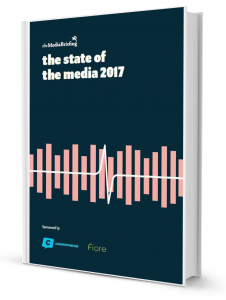At the beginning of this year, we looked back to 2015 and the trends that had evolved in the digital publishing industry. New distribution platforms, the role of mobile, video content, live streaming apps, and the ad-blocking problem were the most important subjects we pointed out then. Now, almost a year later, theMediaBriefing released their “State of the Media 2017” report. Let’s have a look and see whether the topics that were top-of-mind to many publishers in 2015 will still be present in 2017.
Distribution platforms remain difficult to monetize
Big tech companies like Apple, Facebook and Twitter started getting involved in news distribution by the end of 2015. With apps like Moments (Twitter), Instant Articles (Facebook) and Discover (Snapchat), the tech giants tried to keep readers on their own platforms longer, while consuming publishers’ content. Most of these distribution platforms offered a service within these platforms for publishers to display ads. However, one of the frequently heard criticisms about the platforms is that it’s difficult for publishers to generate revenue from them. And it still is. TheMediaBriefing reports that off-platform publishing is a success, in large part because of the poor mobile experience of many publishers own article pages. These distribution platforms bring a great advantage in terms of their user experience, but the costs for the publisher remain. Bringing content into the walled garden and outside of a publisher’s own domain cuts down traffic to the website and thus opportunities to generate revenue by showing ads and driving conversions.
Publishers will stay mobile-focused
The worldwide adoption of smartphones has made a good mobile strategy crucial. Google confirmed that there are more searches now on mobile than on desktop. Also, according to venture capital firm KPCB global mobile internet usage overtook desktop in 2015 already: 51% of total time spent on the internet is on mobile devices, compared to 42% on desktop. No wonder, many publishers are thinking mobile first. In the report, mobile is pointed out as the 4th area in which publishers will be investing in most heavily in 2017. An ever increasing number of consumers use their phones for digital media: over 40% of internet users between 16 and 64 years old listed their phone as the most important device for going online – more than laptops and desktops with 30%. Questions like: “How can you optimize your web content for mobile viewing,” “what would make your audience put your app on their home screen,” and “which third-party apps are popular with your audience” remain hugely important for publishers to ask themselves in 2017.
Video – is it a bubble and will it burst?

2015 was the year of the rise of video content, driven mostly by social media platforms such as Facebook, Snapchat and Twitter. Next to that, live streaming apps like Periscope were introduced and some publishers even launched their own live streaming apps. For 2017, theMediaBriefing reports that publishers are still enthusiastic about the video opportunities. This year, the opportunities have evolved further (with e.g. Instagram adding a live video functionality to their platform). Video is appointed as the second area – after data – in which publishers expect to be investing in most heavily in 2017. However, there are still lingering questions about the best way to monetize video and about how popular video actually is, since executives of Facebook have predicted video to become huge while at the same time giving it priority in people’s social streams.
Ad blocking is still on the rise
Adobe and PageFair reported that worldwide, 200 million people used an ad blocker in 2015. That year the ad-blocking debate had reached a new height due to the fact that Apple started getting involved by offering content-blockers to their users. Publishers often responded by blocking access to their articles for users that were using an ad blocker. Axel Springer claimed that over two-thirds of their traffic switched off their ad blocker after their blockade and they even took legal action against the people that created apps to avoid the blockade. Currently, 309 million people are blocking ads on the mobile web, an increase of more than 50%. Display advertising has been the basis of many online publishers’ business models and still makes up a huge portion of their revenues. However, ad blocking is just one of the outcomes of a bad user experience due to aggressive and irritating ads. So in 2017, a lighter, better, more relevant advertising experience is crucial for digital display to survive as an income stream for publishers.
The biggest challenges and opportunities in 2017 identified
2015 and 2016 were years in which we saw some big changes for digital publishing, and 2017 is looking to continue that trend. In light of the continuous struggles facing publishers, there are still many opportunities ahead. Here are some of our other articles about trends and challenges in digital publishing that you might find interesting:

Curious what media executives worldwide have identified as their biggest challenges and opportunities for 2017?
Download the State of the Media 2017 report here for free!